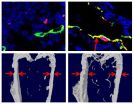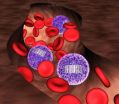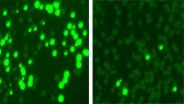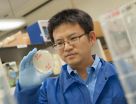(Press-News.org) Experiments in mice with a bone disorder similar to that in women after menopause show that a scientifically overlooked group of cells are likely crucial to the process of bone loss caused by the disorder, according to Johns Hopkins researchers. Their discovery, they say, not only raises the research profile of the cells, called preosteoclasts, but also explains the success and activity of an experimental osteoporosis drug with promising results in phase III clinical trials.
A summary of their work will be published on Oct. 5 in the journal Nature Medicine.
"We didn't know that the drug affects preosteoclasts, nor did we understand how important preosteoclasts are in maintaining healthy bones," says Xu Cao, Ph.D., the Lee H. Riley Jr., M.D., Professor of Orthopaedic Surgery. "Now drug companies hoping to reverse osteoporosis can look for even more drugs that make use of and target these interesting cells."
The bones of mice, people and all land animals are not only necessary for strength and structure, but also as warehouses for calcium, which cells throughout the body use continuously for everyday tasks like cell-to-cell communication, muscle strength, and even embryo fertilization and hormone balance.
Calcium is taken from digested food and stored in the semihollow space inside bones. To access the stored calcium, the inner bone goes through a process called resorption, in which cells called osteoclasts attach to the bone and dissolve the calcium and other stored minerals. Nearby, specialized blood vessels pick up the calcium and send it throughout the body. They also bring in nutrients needed for new bone formation.
Under normal conditions, bone resorption is carefully balanced with bone rebuilding to maintain bone strength. But in women who have entered menopause, decreases in estrogen can cause bone resorption to overcome bone rebuilding, leading to osteoporosis and frequent bone breaks. In the U.S., an estimated 25 million women have osteoporosis.
"Most osteoporosis drugs on the market slow down bone resorption but do nothing to encourage bone rebuilding," says Cao. Previous data, including that from early clinical trials in humans, indicated that the drug odanacatib decreases bone resorption by hobbling CTSK, one of the enzymes used to resorb bone. What came as a pleasant surprise was that the same drug also increased bone rebuilding, but the question was how it did so, Cao says.
To learn more, Cao and his team studied mice genetically engineered to have neither bone-dissolving osteoclasts nor their precursors, preosteoclasts. Though the inner bones of the mice were abnormal, as expected, the team also found that the outside layers of the bones were thin. Moreover, the specialized blood vessels needed to transport bone-building supplies were in scarce supply, suggesting overall that osteoclasts and their precursors regulate bone building and bone resorption.
The team grew the two cell types separately in the laboratory and collected the liquid around them to test for proteins released by the cells. They found that preosteoclasts — but not mature osteoclasts — secrete a protein called PDGF-BB, which is a powerful attracter both of cells that make bone-building cells and those that make the specialized blood vessels. As expected, when the preosteoclasts of mice were prevented from making PDGF-BB, the mice had weak bones.
"Before a new building is constructed, the roads have to be in place so that the materials and equipment can be brought in," says Cao. "In a similar way, preosteoclasts call blood vessels into an area before bone-building cells begin to make new bone."
When mice were given L-235, the animal form of odanacatib, the numbers of their preosteoclasts and osteoclasts increased, and they secreted more PDGF-BB. The increased PDGF-BB brought in more cells for making blood vessels and bone, which led to more of the specialized blood vessels and thicker bones.
To see if the drug could help reverse the increased bone resorption and decreased blood vessel formation of postmenopausal osteoporosis, the researchers simulated menopause in female mice by removing their ovaries. At first, the mice had thinner bones and fewer blood vessels, but treatment with the drug increased the concentration of PDGF-BB in the blood, the number of specialized blood vessels both inside and outside of the bones, and the overall thickness and density of the bone.
According to Cao, in addition to slowing bone resorption by blocking CTSK, an osteoclast "weapon," the drug also appears to slow down the maturation of preosteoclasts, lengthening the amount of time they secrete PDGF-BB before becoming osteoclasts. With increased PDGF-BB, more specialized blood vessels are made and more bone-building cells arrive, restoring the balance between bone resorption and bone rebuilding.
Odanacatib is produced by Merck & Co. Inc. and has already gone through phase III clinical trials with good results, according to Cao. "It is unusual to see a single drug that decreases bone resorption and increases bone rebuilding at the same time," says Cao. "Beyond that, we now know just how important preosteoclasts and PDGF-BB are to bone building, which is information we can use in designing future studies."
INFORMATION:
Other authors of the report include Hui Xie, Zhuang Cui, Long Wang, Zhuying Xia, Yin Hu, Lingling Xian, Changjun Li, Liang Xie, Janet Crane, Mei Wan, Gehua Zhen, Qin Bian, Weizhong Chang and Tao Qiu of the Johns Hopkins University School of Medicine, plus additional authors from other institutions.
This work was supported by grants from the National Institute of Diabetes and Digestive and Kidney Disorders (DK057501), the National Institute of Arthritis and Musculoskeletal and Skin Diseases (AR063943), China's National Science Fund for Distinguished Young Scientists (81125006) and Merck.
On the Web:
View the article at Nature Medicine. http://dx.doi.org/10.1038/nm.3668
Visit the Cao Lab's website. http://www.hopkinsmedicine.org/profiles/results/directory/profile/0000003/xu-cao
The largest genome-wide association study (GWAS) to date, involving more than 300 institutions and more than 250,000 subjects, roughly doubles the number of known gene regions influencing height to more than 400. The study, from the international Genetic Investigation of Anthropometric Traits (GIANT) Consortium, provides a better glimpse at the biology of height and offers a model for investigating traits and diseases caused by many common gene changes acting together. Findings were published online October 5 by Nature Genetics.
"Height is almost completely determined ...
A 7-year-project to develop a barcoding and tracking system for tissue stem cells has revealed previously unrecognized features of normal blood production: New data from Harvard Stem Cell Institute scientists at Boston Children's Hospital suggests, surprisingly, that the billions of blood cells that we produce each day are made not by blood stem cells, but rather their less pluripotent descendants, called progenitor cells. The researchers hypothesize that blood comes from stable populations of different long-lived progenitor cells that are responsible for giving rise to ...
This news release is available in French and German. Physicians and researchers at CHU Sainte-Justine, Université de Montréal, CHU de Québec, Université Laval, and Hubrecht Institute have discovered a rare disease affecting both heart rate and intestinal movements. The disease, which has been named "Chronic Atrial Intestinal Dysrhythmia syndrome" (CAID), is a serious condition caused by a rare genetic mutation. This finding demonstrates that heart and guts rhythmic contractions are closely linked by a single gene in the human body, as shown in a study published on October ...
A new crystallographic technique developed at the University of Leeds is set to transform scientists' ability to observe how molecules work.
A research paper, published in the journal Nature Methods on October 5, describes a new way of doing time-resolved crystallography, a method that researchers use to observe changes within the structure of molecules.
Although fast time-resolved crystallography (Laue crystallography) has previously been possible, it has required advanced instrumentation that is only available at three sites worldwide. Only a handful of proteins ...
A study published in Nature Geoscience shows that air pollution has had a significant impact on the amount of water flowing through many rivers in the northern hemisphere.
The paper shows how such pollution, known as aerosols, can have an impact on the natural environment and highlights the importance of considering these factors in assessments of future climate change.
The research resulted from a collaboration between scientists at the Met Office, Centre for Ecology and Hydrology, University of Reading, Laboratoire de Météorologie Dynamique in France, and the University ...
The multitude of microbes scientists have found populating the human body have good, bad and mostly mysterious implications for our health. But when something goes wrong, we defend ourselves with the undiscriminating brute force of traditional antibiotics, which wipe out everything at once, regardless of the consequences.
Researchers at Rockefeller University and their collaborators are working on a smarter antibiotic. And in research to be published October 5 in Nature Biotechnology, the team describes a 'programmable' antibiotic technique that selectively targets the ...
Type 2 diabetes affects an estimated 28 million Americans according to the American Diabetes Association, but medications now available only treat symptoms, not the root cause of the disease. New research from Rutgers shows promising evidence that a modified form of a different drug, niclosamide – now used to eliminate intestinal parasites – may hold the key to battling the disease at its source.
The study, led by Victor Shengkan Jin, an associate professor of pharmacology at Rutgers Robert Wood Johnson Medical School, has been published online by the journal Nature ...
Montréal, October 2, 2014 – Scientists at the IRCM discovered a mechanism that promotes the progression of medulloblastoma, the most common brain tumour found in children. The team, led by Frédéric Charron, PhD, found that a protein known as Sonic Hedgehog induces DNA damage, which causes the cancer to develop. This important breakthrough will be published in the October 13 issue of the prestigious scientific journal Developmental Cell. The editors also selected the article to be featured on the journal's cover.
Sonic Hedgehog belongs to a family of proteins that gives ...
Despite the legalization of same-sex marriage in 19 states and the District of Columbia and an executive order to prohibit federal contractors from discrimination against lesbian, gay, bisexual, and transgender employees, LGBT individuals face tremendous hurdles in access to health care and basic human rights. A special report published by The Hastings Center, LGBT Bioethics: Visibility, Disparities, and Dialogue, is a call to action for the bioethics field to help right the wrongs in the ways that law, medicine, and society have treated LGBT people.
The editors are Tia ...
FALLS CHURCH, Va. (October 3, 2014) — A new National Institute for Occupational Safety and Health (NIOSH) study, published online in the Journal of Occupational and Environmental Hygiene, found that recommended safe handling practices for workers who administer antineoplastic drugs in healthcare settings are not always followed.
Results are derived from the 2011 Health and Safety Practices Survey of Healthcare Workers, the largest federally-sponsored survey of healthcare workers in the U.S., which addresses safety and health practices relative to use of hazardous chemicals. ...



